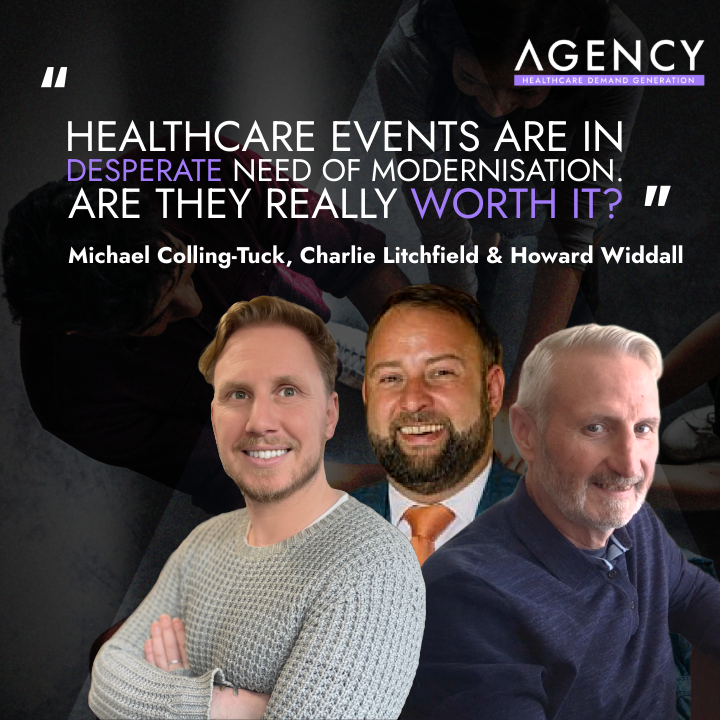The £65K Reality Check: Why Most Healthcare Events Fail to Create Demand
- AGENCY

- Aug 19
- 3 min read
Updated: Aug 20
A century of combined healthcare experience reveals what's really happening at those expensive exhibition booths - and what actually works.
Healthcare events represent the single largest marketing investment many companies make, yet they consistently deliver the lowest demand creation returns. In our latest Agency Fireside Chat, we brought together over 100 years of combined healthcare experience to dissect exactly why this happens—and what smart companies do instead.
The Uncomfortable Truth About Event ROI
Charlie Litchfield, who spent 20 years managing events for major healthcare brands, shared a sobering example that perfectly captures the industry's event problem:
The numbers: £65,000 booth investment. 400 badge scans. 7 qualified prospects. The reality: £9,300 per meaningful conversation.
This isn't an outlier - it's representative of what happens when companies treat events as moments in time rather than strategic campaign phases.
The Four Traps That Kill Event Success
Our discussion revealed four critical scenarios where even smart healthcare leaders make costly event decisions:
1. The Customer Hostage Situation
When your biggest customer says, "I expect to see you at this conference," relationship management fear often masquerades as marketing strategy. Howard Widdall, former VP EMEA at Smith & Nephew, emphasised the importance of asking clarification questions: Why do they want you there, and in what form should your support take?
2. The Management Visibility Trap
C-suite demands for "brand visibility" and competitive positioning frequently trump strategic demand creation decisions. As Keith Jackson, healthcare CEO with 35+ years of experience, pointed out: visibility without purpose is expensive wallpaper.
3. The Salesforce Revolt
Sales teams push for bigger, shinier booths, believing size equals pipeline growth. But technique trumps size every time. One company doubled their booth size and saw 40% more website traffic - yet their pipeline remained completely flat.
4. The Messaging Meltdown
When every healthcare company defaults to "patient first" messaging, differentiation becomes impossible. Generic messaging that could apply to anyone creates a sea of sameness that customers tune out.
What Actually Creates Demand at Events
The most successful event strategies we discussed shared common elements:
Strategic Alternatives Over Default Presence. One client spent a few thousand dollars renting a hotel meeting room near the congress centre instead of building an expensive booth. Result: 20-25 pre-scheduled meetings with key accounts, with two-thirds converting to real opportunities and several closing within three months.
Pre-Event Preparation That Actually Works The companies that succeed treat events like campaigns, not moments. They conduct "pre-match training" with sales teams, establish clear messaging frameworks, and book customer meetings in advance rather than hoping for booth traffic.
Data-Driven Decision Making Smart companies track more than badge scans. They measure qualified prospects, pipeline impact, and post-event engagement. This data becomes their defence against pressure to attend every "must-have" event.
Post-Event Engagement Strategy The racing simulator example Keith shared was brilliant—not just for booth traffic, but because it gave sales teams a reason to reconnect: "I see you finished seventh on the leaderboard. I thought you were better than Dr. Smith..."
The Seven-Question Framework That Changes Everything
Based on our collective experience, here's the strategic framework that separates successful events from expensive mistakes:
Strategic Alignment: Does this event fit within your communications strategy?
Presence Strategy: How should you show up? (Booth, symposium, off-site meetings?)
Pre-Preparation: What outreach and team training will you complete beforehand?
Message Clarity: What do you want attendees to hear, and what do they want to learn?
Delivery Excellence: How will your space and team communicate your message effectively?
Data Strategy: What insights will you collect and how will you use them?
Continued Engagement: What reasons will you have to reconnect post-event?
The Bottom Line for Healthcare Marketing Leaders
Events aren't inherently bad investments - but treating them as tactical decisions rather than strategic campaign phases is. The companies getting real demand creation results are the ones asking harder questions, collecting better data, and thinking beyond the exhibition hall.
As our discussion revealed, the recognition that innovative healthcare products deserve comes not from the biggest booth, but from the smartest strategy.
Want to hear the full discussion? Watch our complete Agency Fireside Chat below, where Keith Jackson, Howard Widdall, Charlie Litchfield, and Michael Colling-Tuck share specific examples, tactical insights, and hard-won lessons from managing healthcare events across five continents.
Ready to transform your event strategy from expense to investment? Let's discuss how strategic demand creation can deliver the results your innovative healthcare solutions deserve.
.jpg)

Comments